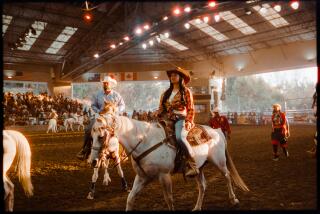America in black and white
- Share via
Bruce Davidson’s “Time of Change: Civil Rights Photographs, 1961-1965” isn’t strictly a book of civil rights pictures, but all of the pictures -- mostly of blacks in Harlem, Chicago, Washington and the American South -- are about the civil rights movement, the early ‘60s African American awakening expressed most publicly in Southern protest and more quietly elsewhere.
Early on, we see a group of satisfied and smiling Harlem matrons in hats at a luncheon banquet opposite a picture of a mother in a hat with a child and gloves in hand before an NAACP information desk. Later, black men in dark suits and women in furs laugh at jokes we do not hear and look at scenes we cannot see.
Those merry matrons, sitting before shining silverware and neatly folded white napkins, those men and women so finely dressed, express the movement’s goals -- identity and pride in self -- as surely as the woman with a “Jim Crow must go” picket sign a page away.
Davidson, a member of Magnum Photos when many of these pictures were taken, had also been a Life photographer, but most of these images result from a 1962 Guggenheim Fellowship. They were rewarded with a 1966 National Endowment for the Arts grant, the first of its kind offered for photography by the NEA. “Time of Change” joins other collections of photographs of the civil rights movement by Danny Lyon, Herbert Randall and Bob Adelman.
Davidson catches many subjects unaware, or aware but not caring that this white stranger has taken their picture: in repose in a tenement window, waiting in a surplus food line, lounging outside a barbershop, whispering to father, asleep on a newspaper bed on a beach or shoeless on a park bench. A young Louis Farrakhan sits at a Malcolm X rally as a somber crowd watches. In some pictures, eyes stare back at the camera; in the rest, folks just carry on with their lives, their work.
The Southern photographs repeat many of the Northern images: Grandmother and granddaughter embrace in church, fans in hand. Black miners, dirty from the day’s labor, trudge home. While the same people may be found in New York, even in similar settings, Davidson lets us know this isn’t Harlem by the atmosphere he captures. The “white” toilet and restaurant signs, the seated white boss looking down on the black man in the ditch, the backyard chicken coop and 4-H float, the black nannies and their white charges resting under a magnolia tree, the cotton pickers, a boy with a mule -- these shout “South” -- summon up America’s era of apartheid and distinguish themselves from New York street scenes.
Davidson’s skill with the camera lies in the intimacy he brings to each shot. His pictures put the viewer in the scene, behind, for instance, Freedom Rider John Lewis’ bandaged head. We watch as Martin Luther King Jr. listens pensively, and Freedom Riders, sprawled on a floor, raise hands to cast votes. Or we’re on the bus, with a long line of police cars trailing outside a window, as it passes white hecklers or combat-suited soldiers. Or we’re in Birmingham’s Kelley Ingram Park as hoses blast. A girl is arrested before a movie marquee that screams, “Damn the Defiant!”
There are few pictures of the famous; most of these men and women are anonymous except for the photographer’s recording, but it was they who made the movement, not the well-known people (whom the movement made).
Davidson’s black-and-white images are both familiar and new. We’ve seen these people and these scenes before -- these moments, this epoch, is so seared into our minds -- but not with this clarity. So many seem to be thinking, not posing, not arranging face and body to present themselves in any special way, but thinking. When they look straight at us, blacks, whites, Klansmen, policemen, miners, children, they all seem to say, “Here I am. This is me. Take me as I am.”
In assembling these pictures, the story that Davidson tells is one of resignation, anger, courage and triumph. Not surprisingly, the closing section contains photos of 110-year-old Mother Brown, caught on a New York Harbor cruise and in her Harlem home. You can almost hear her delight -- see her delight -- as she sees the Statue of Liberty from the deck of the cruise ship.
Historian Deborah Willis in her foreword to “Time of Change” calls Davidson “both participant and observer,” but you will not feel or see him in these pages. He steps aside to tell you, as Congressman John Lewis’ introduction says, “It did happen.”
It did happen. These people did live this way and act this way and do these things, and we have to be thankful Bruce Davidson was there to capture and record them and remind us now.


